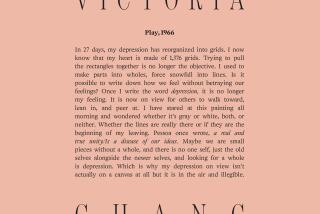‘The Best of It: New and Selected Poems’ by Kay Ryan
Book review: ‘The Best of It: New and Selected Poems’ by Kay Ryan
The Best of It
New and Selected Poems
Kay Ryan
Grove: 270 pp., $24
Contemporary poetry is a bit like visual art. Much of it makes you grab your chin and nod in stumped appreciation — but you wouldn’t want to live with it. Kay Ryan’s work, however, hangs well no matter where it goes. Clouds, calendars, time, birds, jackrabbits. Everything her eye falls upon takes on a brisk, beautifully complete clarity. Her tidy lines disguise an enormous intelligence and tonal warmth: a ferocious capacity for finding the essence of things.
“The Best of It: New and Selected Poems” reveals that right before our eyes Ryan has become a classic American poet. This should hardly be a surprise; she has served as U.S. poet laureate these last two years. But even though she is often compared to Robert Frost, and for good reason, her work here is a revelation. Beginning with new poems, “The Best of It” is the work of a pastoral poet, comfortable with her own counsel but keenly aware of the cost of self-sufficiency. “No unguent / can sooth / the chap of / abandonment,” she writes in “Polish and Balm,” a poem about the mystery of a dead woman’s objects. “Who knew / the polish / and balm in / a person’s / simple passage / among her things.”
Few American poets have used the thin line so well, to such mournful effect. James Schuyler’s poems concealed within their narrow aperture a lyricist’s longing heart; more recently, Lawrence Joseph has found a way to meld the aesthetic rigor of Schuyler with the intellectual spaciousness of Wallace Stevens. Here, we are in different territory altogether. Turning each corner of a Ryan poem, the eye drops to the next solid, well-planked surface, as she guides us closer to the point where collapsing complications are swiftly subverted. The last lines of “Shift” perform this inversion with brutal efficiency.
It’s hard for us
to imagine how small
a part we play in
holding up the tall
spires we believe
our minds erect.
Then North shifts,
buildings shear
and we suspect.
Poems like this, with their unfussy symmetries and patient alliterations, give the lie to all the bloodless revolutions that have occurred in American poetry in recent years. Theories are often mere fancy-dancing. To matter, you need to have something to say, wisdom, a point of view. That’s an uncomfortable idea in many circles, especially as poetry is so often mistaken for high-priced aphorism, a simplifying wedge. True wisdom, though, never simplifies but rather sees complexity with an unsettling clarity. This is why, when we describe poems by Frost or Dickinson, we reach for the word “eerie”: They don’t leave us anywhere to hide.
One of the great reliefs of Ryan’s work is that she brings us to this point of disturbing clarity without telling too much about, well, herself. There are many poets whose intense intimacy and investigation of the self is their strength — Sharon Olds, Mark Doty, C.K. Williams, D.A. Powell — but Ryan’s steely privacy is rare. She gives us access to a different sort of intimacy, an intimacy of the mind. We watch her puzzle and torque; gain purchase on an idea and then let it go with the athletic elegance of Zen thinking. In “Emptiness,” she packs centuries of thinking about the American West into eight brief lines.
Emptiness cannot be
compressed. Nor can it
fight abuse. Nor is there
an endless West hosting
elk, antelope, and the
tough cayuse. This is
true also of the mind:
It can get used.
Each line sets up the next, which arrives with a pleasing sense of inevitability because of the repeating internal rhyme (compressed / abuse / endless). As in so much of her work, Ryan keeps it simple. We are not caught off-guard or dazzled by where she has taken us. Plainspoken and clear-eyed, she tells us something we didn’t know we knew until we get there (“It can get used”). And all this in eight lines. Few poets know how to compress thought so elegantly, while simultaneously keeping their lines so seemingly loose and vernacular.
“The Best of It,” like so many selected collections, does not contain a shadow autobiography. In fact, Ryan is so sure-handed that the book is consistently good, her preoccupations reassuringly perpetual. She loves to study the fallacies of the mind, to watch the eye make mistakes, to pay tribute to the spooky mystery of nature’s whole bestiary, from zebras to serpents to osprey, to atomize any kind of transformation into its purest elements.
Spending time with this book can alter the mind. The brevity and sobriety within Ryan’s lines have a contagious skepticism to them, leaving us to emerge from her poems feeling not cleansed but quieted. That intense slowing is poetry’s great purpose, how it gets us to see. We slow down enough to learn a new language; we learn, all over again, how to see everything from the passage of days to the blur of a hailstorm, which Ryan describes as “A maelstrom / of ferocious little / fists and punches, / so hard to believe / once it’s past.” Eventually, this too shall pass, “The Best of It” reminds us, like everything.
Freeman is the editor of Granta magazine.
More to Read
The biggest entertainment stories
Get our big stories about Hollywood, film, television, music, arts, culture and more right in your inbox as soon as they publish.
You may occasionally receive promotional content from the Los Angeles Times.






